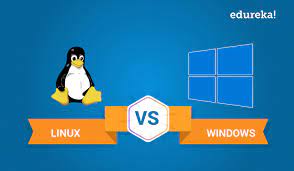The 7 Key Differences Between Windows And Linux

The 7 Key Differences Between Windows And Linux
There are seven key differences between Windows and Linux: the kernel, the desktop environment, the package manager, the file system, the networking, the software repository and the community.
The kernel is the core of an operating system. Windows has a monolithic kernel, which means that all of the core components are tightly coupled. This makes Windows more difficult to customize and optimize. Linux has a microkernel architecture, which means that only the essential components are tightly coupled. This makes Linux more flexible and easier to customize.
The desktop environment is the graphical interface that users interact with. Windows uses a proprietary desktop environment called Explorer. Linux uses a variety of open source desktop environments such as GNOME, KDE or Xfce.
The package manager is a tool for installing, updating and removing software packages. Windows uses a proprietary package manager called MSI installer. Linux uses a variety of open source package managers such as aptitude, yum or pacman.
The file system is how files are organized on disk. Windows uses a proprietary file system called NTFS. Linux uses a variety of open source file systems such as ext3, reiserfs or xfs.
The networking is how computers communicate with each other over a network. Windows uses a proprietary networking protocol called TCP/IP. Linux also uses TCP/IP, but it also supports other protocols such as NFS or CIFS.
The software repository is where software packages are stored
what is windows desktop manager
There are several key differences between Windows and Linux, but perhaps the most significant is the way in which each operating system manages your desktop. In Windows, your desktop is managed by the Windows Desktop Manager, while in Linux your desktop is managed by a variety of window managers.
The biggest difference between the two is that the Windows Desktop Manager is a proprietary software application, while most Linux window managers are free and open source. This means that anyone can view and modify the source code for a Linux window manager, whereas only Microsoft can view and modify the source code for the Windows Desktop Manager.
Another key difference is that the Windows Desktop Manager is designed to work with specific hardware, while most Linux window managers will work with a variety of hardware. This means that if you want to use a specific piece of hardware with your Windows machine, you may need to purchase drivers or other software to get it to work properly. With Linux, on the other hand, you can often just plug in new hardware and have it work without any additional configuration.
Finally, the way in which each operating system handles updates and security patches is also quite different. In Windows, you typically need to install updates and security patches manually, while in Linux they are often automatically installed as part of your regular system updates.
enable rdp windows 10

Windows and Linux are two popular operating systems with many similarities and differences. While both operating systems can be used for personal and business purposes, they have different strengths and weaknesses. Here are seven key differences between Windows and Linux:
1. User interface – Windows has a more user-friendly interface than Linux. For example, Windows 10 uses the Start menu while most Linux distributions use a panel-based system.
2. Package management – Windows uses MSI packages while Linux uses DEB packages. This can make it difficult to install software on a Windows system if you’re not familiar with the process.
3. File system – Windows uses NTFS while Linux uses EXT4. This can make it difficult to share files between systems if you’re not using the same file system.
4. Security –Linux is generally considered to be more secure than Windows due to its smaller attack surface and better security features. However, both operating systems can be secured with proper configuration and maintenance.
5. Performance – Linux is often faster than Windows, but this depends on your specific hardware and software configuration.
6. Scalability – Linux is more scalable than Windows, meaning it can handle larger workloads more efficiently. This makes it a good choice for servers or other high-performance computing tasks.
7. Cost – Windows is typically more expensive than Linux since it’s a commercial product with licensing fees. However, there are many free and open source versions of Linux
windows zsh
Windows and Linux are two very different operating systems. They both have their own pros and cons, but there are some key differences that you should be aware of. Here are the 7 key differences between Windows and Linux:
1. User interface – The user interface is one of the most noticeable differences between Windows and Linux. Linux uses a command line interface, while Windows uses a graphical user interface. This can make Linux seem more difficult to use at first, but many people prefer it once they get used to it.
2. Security – One of the benefits of using Linux is that it is much more secure than Windows. This is because Linux is open source, so there are more eyes on it to find security holes. Additionally, Linux has built-in security features that Windows does not have.
3. Cost – Another big difference between these two operating systems is the cost. Windows is a commercial product, so you have to pay for it. On the other hand, Linux is free and open source.
4. Customizability – One of the best things about Linux is that it is highly customizable. You can change almost anything about the way it looks and feels to meet your needs. Windows, on the other hand, is much more limited in this regard.
5. Support – When it comes to support, Windows wins hands down. There are millions of users and thousands of companies that provide support for Windows. Linux has a smaller community, but
